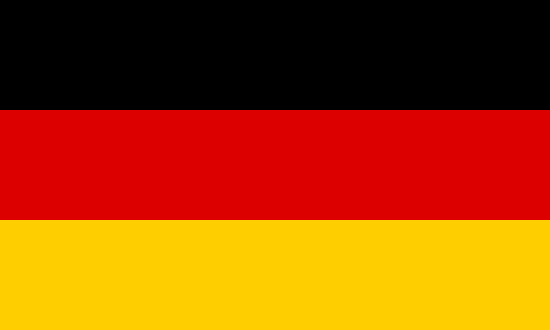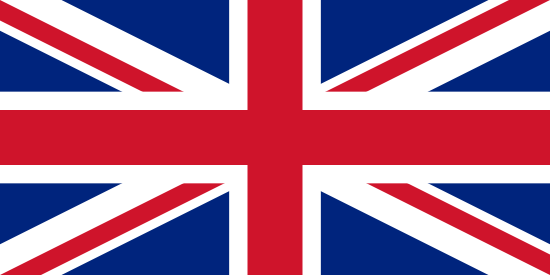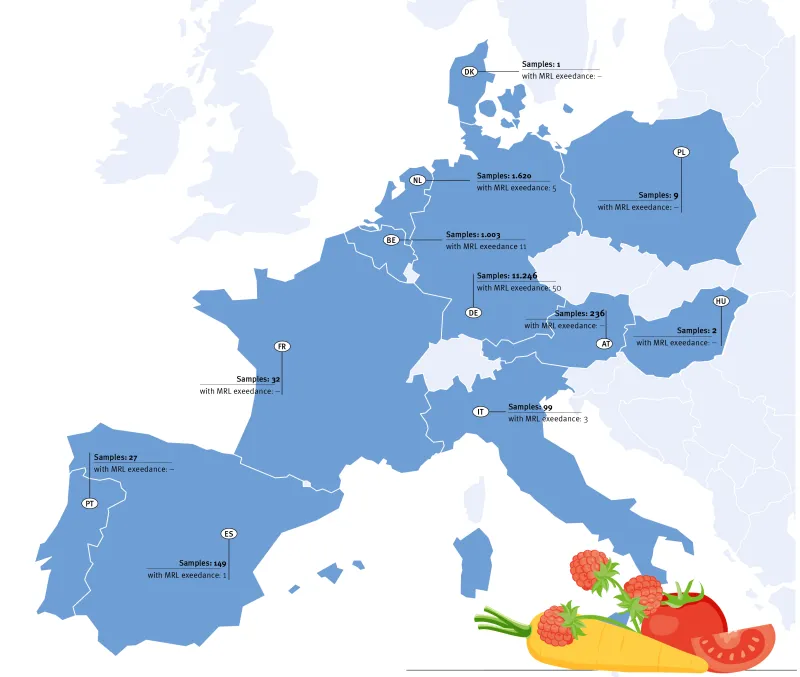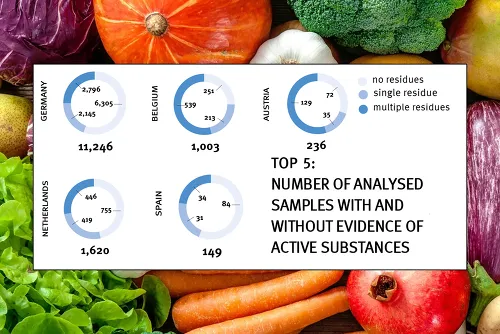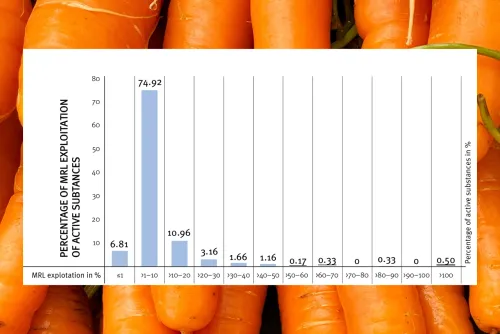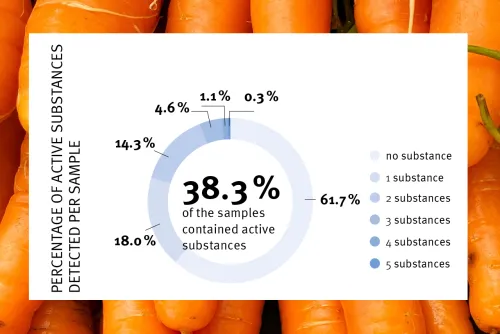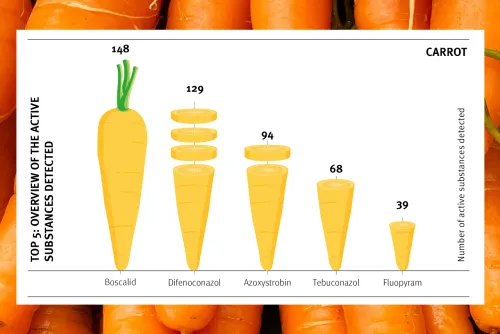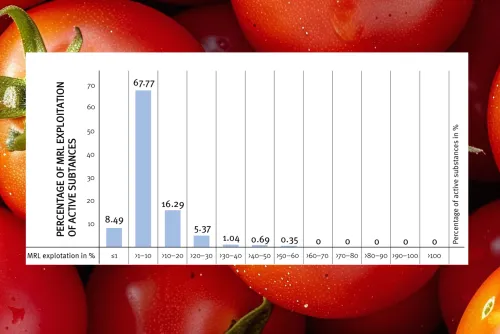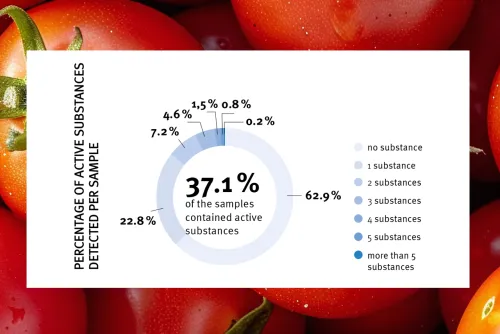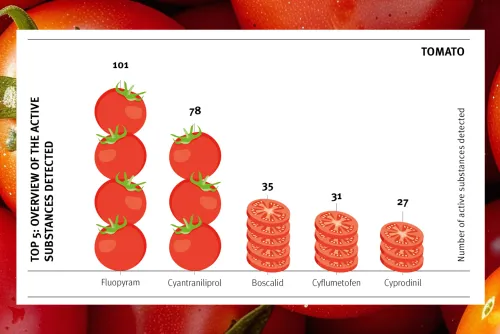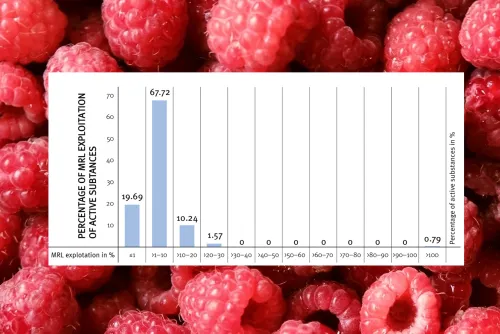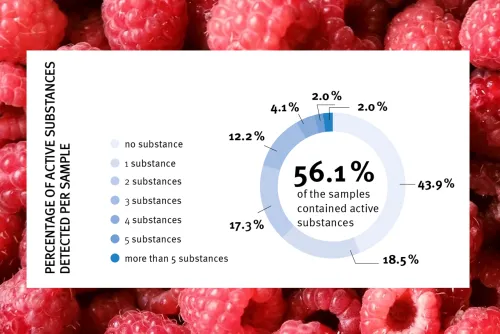QS residue monitoring – an overview of all the latest results
- Evaluation period: October 1, 2023 to September 30, 2024
- Total number of samples evaluated: 14,520 (for comparison: 15,580 (2023) / 17,047 (2022) / 16,725 (2021))
- Number of analyzed samples from Germany: 11,246
- Number of analyzed samples from the EU including Germany: 14,424
- Number of samples from third countries evaluated: 96
- Number of samples without exceeding the MRL (total): 14,518 (in comparison: 15,767 (2023) / 16,932 (2022) / 16,642 (2021))
- Number of samples exceeding the MRL (total)*: 72 (by comparison: 113 (2023), 115 (2022) / 83 (2021))
- Excess rate (total): 0.495% (by comparison: 0.71% (2023) / 0.67% (2022) / 0.48% (2021))
- Non-compliance rate for products from Germany: 0.44% (by comparison: 0.66% (2023) / 0.64% (2022) / 0.45% (2021))
- Excess rate for products from Europe (including Germany): 0.485 % (by comparison: 0.70 % (2023) / 0.64 % (2022) / 0.48 % (2021))
- Number of sample countries: 28 (by comparison: 33 (2023) / 41 (2022) / 45 (2021))
* The basis is the actual value (measured value without taking into account an expanded measurement uncertainty of ± 50 percent).
Number of samples analyzed with and without detection of active ingredients (top 5 in Europe)
6,305 of a total of 11,246 fruit and vegetable samples from Germany showed no residues of plant protection product active substances. In 2,145 samples from Germany, one plant protection product active ingredient could be detected, while the remaining 2,796 samples showed residues of several active substances. The infographic shows the ratio of fruit and vegetable samples with no residues to samples with single and multiple residues in the Netherlands, Belgium, Austria and Spain.
For the residue monitoring, QS evaluated 904 samples (carrots, both in bunches and loose), of which 689 came from Germany, 132 from the Netherlands and 40 from Spain. No residues were detected in 61.7 percent of the samples. 36.9 percent of the samples contained between 1 and a maximum of 3 active substances. Only 3 samples (0.33 percent) were found to exceed the maximum residue level (MRL). For 92.69% of the active substances found, the utilization of the maximum residue level was 20% or less. The most frequently detected active substances included boscalid (148 detections), difenoconazole (129 detections) and thiacloprid (118 detections).
Number of samples and main countries of origin of the analyzed samples
-
Number of samples analyzed (total): 904
- Number/percentage of samples from Germany: 689 samples / 76.2 %
- Number/percentage of samples from EU (excluding Germany): 214 samples / 23.7 %
-
Most important countries of origin in the EU (excluding Germany):
- Netherlands (132 samples /14.6% of samples)
- Spain (40 samples /4.2% of samples)
- Portugal (20 samples /2.2%)
RHG utilization of the active substances and samples with unauthorizedactive substances
- Click on the graphic to enlargeNumber of samples without MRL exceedance: 901
- Number of samples exceeding the MRL: 3 (active substances: linuron, ethofumesate, aclonifen)
- Exceeding rate (total): 0.33%
- The utilization of the maximum residue levels was 92.69% of the active substances found at a maximum of 20% (see graphic)
- Number of samples with unauthorized active substances: 0
Rate of detected active substances per sample
- Samples without active substance detection: 577 / 61.1 % of samples
- Samples with active substance detection: 347 / 38.4 % of samples
- Samples with multiple residues: 184 / 20.3 % of samples
- Samples with 1 detected active substance: 163 / 18.0 % of the samples
- Samples with 2 detected active substances: 129 / 14.3 % of the samples
- Samples with 3 detected active substances: 42 / 4.6 % of the samples
- samples with 4 detected active substances: 10 / 1.1 % of samples
- samples with ≥ 5 detected active substances: 3 / 0.3 % of samples
Of the 917 tomato samples, 363 came from Germany, 280 from the Netherlands and 263 from Belgium. None of the samples exceeded the legal maximum residue levels (MRLs). For 92.55 percent of the samples, the MRLs were only used to a maximum of 20 percent. 62.9 percent of the samples were free of plant protection product residues. In six samples, an active substance not approved for the crop was detected. A total of 46 active substances were detected, most frequently fluopyram (101 times), cyantraniliprole (78 times) and boscalid (35 times). In addition, there were five cases of the MRL being exceeded for the active substance chlorate, which is no longer approved. These were excluded from the evaluation because they did not result from the use of a plant protection product, but from disinfection measures.
Number of samples and main countries of origin of the analyzed samples
-
Total number of samples analyzed: 917
- Number/percentage of samples from Germany: 363 samples / 39.6 %
- Number/percentage of samples from the EU (excluding Germany): 552 samples / 60.2 %
-
Most important countries of origin in the EU (excluding Germany):
- Netherlands (280 samples / 30.5% of samples)
- Belgium (263 samples / 28.7% of samples)
RHG utilization of active substances
- Click on the graphic to enlargeNumber of samples without exceeding MRL: 917 (100.0% of samples)
- Number of samples with exceeding MRL: 0
- Exceeding rate (total): 0.0%
- The utilization of the maximum residue levels was less than 20% for 92.55% of the active substances found (see graphic)
- Number of samples with unauthorized active substances: 0
Rate of detected active substances per sample
- Samples without active substance detection: 577 / 62.9 % of samples
- Samples with active substance detection: 340 / 37.1 % of samples
- Samples with multiple residues: 131 / 14.3 % of samples
-
- Samples with 1 detected active substance: 209 / 22.8 % of samples
- Samples with 2 detected active substances: 66 / 7.2 % of samples
- Samples with 3 detected active substances: 42 / 4.6 % of samples
- samples with 4 detected active substances: 14 / 1.5 % of samples
- samples with 5 detected active substances: 7 / 0.8 % of samples
- samples with more than 5 detected active substances: 2 / 0.2 % of samples
Of the 98 raspberry samples analyzed, 85 came from Germany, followed by the Netherlands (12 samples) and one sample from Belgium. Only one sample exceeded the MRL. 97.64 percent of the active substances detected in the raspberry samples only utilized the MRL up to a maximum of 20 percent. 43.9 percent of all samples were free of active substances, 18.5 percent contained one active substance and 37.6 percent contained two or more active substances. The active substances most frequently detected were fludioxonil (25 times), cyprodinil (24 times) and spinosad (13 times). A total of 15 different active substances from plant protection products were detected in the samples.
Number of samples and main countries of origin of the analyzed samples
-
Total number of samples analyzed: 98
- Number/percentage of samples from Germany: 85 samples / 86.7 %
- Number/percentage of samples from the EU (excluding Germany): 13 samples / 13.3 %
- Most important countries of origin in the EU (excluding Germany):
- Netherlands (12 samples / 12.2% of samples)
- Belgium (1 sample / 1.02% of samples)
RHG utilization of the active substances and samples with unauthorized active substances
- Number of samples without exceeding MRLs: 97
- Number of samples with MRLs exceeded: 1 (active substances: lambda and gamma cyhalothrin)
- Excess rate (total): 1.02 %
- The utilization of the maximum residue levels was less than 20% for 97.64% of the active substances found (see graphic)
- Number of samples with unauthorized active substances: 0
- Rate of non-compliance with unauthorized active substances: 0.0 %
- Number of samples with unauthorized active substances and MRL exceeded: 0
- Total rate of non-compliance (MRL exceeded & unauthorized active substances): 0.0 %
Rate of detected active substances per sample
Click on the graphic to enlarge
- Samples without active substance detection: 43 / 43.9 % of the samples
- Samples with active substance detection: 55 / 56.1 % of the samples
- Samples with multiple residues: 37 / 37.8 % of the samples
- Samples with 1 detected active substance: 18 / 18.5 % of the samples
- Samples with 2 detected active substances: 17 / 17.3 % of the samples
- Samples with 3 detected active substances: 12 / 12.2 % of the samples
- samples with 4 detected active substances: 4 / 4.1% of samples
- samples with 5 detected active substances: 2 / 2.0% of samples
- samples with more than 5 detected active substances: 2 / 2.0% of samples
